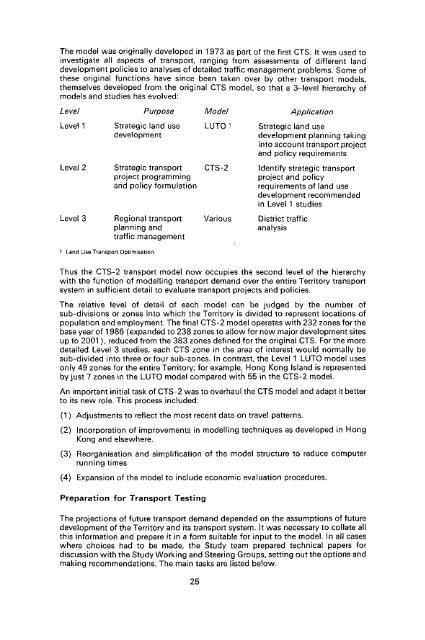Untitled - HKU Libraries - The University of Hong Kong
Untitled - HKU Libraries - The University of Hong Kong
Untitled - HKU Libraries - The University of Hong Kong
- No tags were found...
You also want an ePaper? Increase the reach of your titles
YUMPU automatically turns print PDFs into web optimized ePapers that Google loves.
<strong>The</strong> model was originally developed in 1973 as part <strong>of</strong> the first CIS. ft was used toinvestigate all aspects <strong>of</strong> transport ranging from assessments <strong>of</strong> different landdevelopment policies to analyses <strong>of</strong> detailed traffic management problems. Some <strong>of</strong>these original functions have since been taken over by other transport models,themselves developed from the original CIS model, so that a 3-ieve! hierarchy <strong>of</strong>models and studies has evolved:Level Purpose Model ApplicationLevel 1 Strategic land use LUTO 1 Strategic land usedevelopmentdevelopment planning takinginto account transport projectand policy requirementsLevel 2 Strategic transport CTS-2 Identify strategic transportproject programmingproject and policyand policy formulationrequirements <strong>of</strong> land usedevelopment recommendedin Level 1 studiesLevel 3 Regional transport Various District trafficplanning andanalysistraffic management1 Land Use Transport OptimisationThus the CTS-2 transport model now occupies the second level <strong>of</strong> the hierarchywith the function <strong>of</strong> modelling transport demand over the entire Territory transportsystem in sufficient detail to evaluate transport projects and policies.<strong>The</strong> relative level <strong>of</strong> detail <strong>of</strong> each model can be judged by the number <strong>of</strong>sub-divisions or zones into which the Territory is divided to represent locations <strong>of</strong>population and employment. <strong>The</strong> final CTS-2 model operates with 232 zones for thebase year <strong>of</strong> 1986 (expanded to 238 zones to allow for new major development sitesup to 2001), reduced from the 383 zones defined for the original CTS. For the moredetailed Level 3 studies, each CTS zone in the area <strong>of</strong> interest would normally besub-divided into three or four sub-zones. In contrast, the Level 1 LUTO model usesonly 49 zones for the entire Territory; for example, <strong>Hong</strong> <strong>Kong</strong> Island is representedby just 7 zones in the LUTO model compared with 55 in the CTS-2 model.An important initial task <strong>of</strong> CTS-2 was to overhaul the CTS model and adapt it betterto its new role. This process included:(1) Adjustments to reflect the most recent data on travel patterns.(2) Incorporation <strong>of</strong> improvements in modelling techniques as developed in <strong>Hong</strong><strong>Kong</strong> and elsewhere.(3) Reorganisation and simplification <strong>of</strong> the model structure to reduce computerrunning times(4) Expansion <strong>of</strong> the model to include economic evaluation procedures.Preparation for Transport Testing<strong>The</strong> projections <strong>of</strong> future transport demand depended on the assumptions <strong>of</strong> futuredevelopment <strong>of</strong> the Territory and its transport system, it was necessary to collate allthis information and prepare it in a form suitable for input to the model. In all caseswhere choices had to be made, the Study team prepared technical papers fordiscussion with the Study Working and Steering Groups, setting out the options andmaking recommendations, <strong>The</strong> main tasks are listed below.25
















